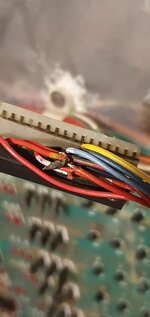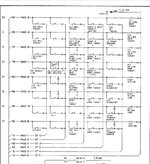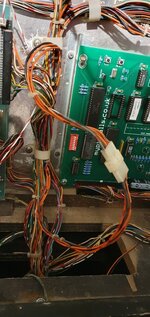I'm getting very frustrated with this issue, I don't know what else to try.
During gameplay the left pop bumper (sometimes the right but it's rare) randomly fires when you're flipping. I can press the flipper button lots and at some point the left jet will fire.
I've checked the switch, even taped it so it can't make contact.
I can prop up the playfield, start a game (by pressing trough switches so it thinks there's balls), then flip with either flipper and the pop bumper will occasionally fire.
With it taped it still fires but doesn't score, which is also odd as surely with the switch able to make contact it shouldn't vibrate shut by the pop activating?
Here's an example
I've tried a new capacitor on the switch, as well as cutting it off, new diode.
Disconnecting the lane change switches on the flipper buttons.
Added caps to the flipper buttons (like on Williams games)
Redid the switch column connector on the board as it looked like this (coincidentally the knackered wire is the same column as the left jet (thumper bumper)

When it happens and if it scores it only scores 1000, so I'm not sure if it could be another switch, or I'd get points from that too?
Here's a copy of the switch matrix, although I'm not sure if it's really switch related.

The game has a brand new repro Nvram mpu, sdb and sound boards. The only original boards are the lamp boards and power rectifier.
At my wit's end
During gameplay the left pop bumper (sometimes the right but it's rare) randomly fires when you're flipping. I can press the flipper button lots and at some point the left jet will fire.
I've checked the switch, even taped it so it can't make contact.
I can prop up the playfield, start a game (by pressing trough switches so it thinks there's balls), then flip with either flipper and the pop bumper will occasionally fire.
With it taped it still fires but doesn't score, which is also odd as surely with the switch able to make contact it shouldn't vibrate shut by the pop activating?
Here's an example
I've tried a new capacitor on the switch, as well as cutting it off, new diode.
Disconnecting the lane change switches on the flipper buttons.
Added caps to the flipper buttons (like on Williams games)
Redid the switch column connector on the board as it looked like this (coincidentally the knackered wire is the same column as the left jet (thumper bumper)

When it happens and if it scores it only scores 1000, so I'm not sure if it could be another switch, or I'd get points from that too?
Here's a copy of the switch matrix, although I'm not sure if it's really switch related.

The game has a brand new repro Nvram mpu, sdb and sound boards. The only original boards are the lamp boards and power rectifier.
At my wit's end
Last edited:


